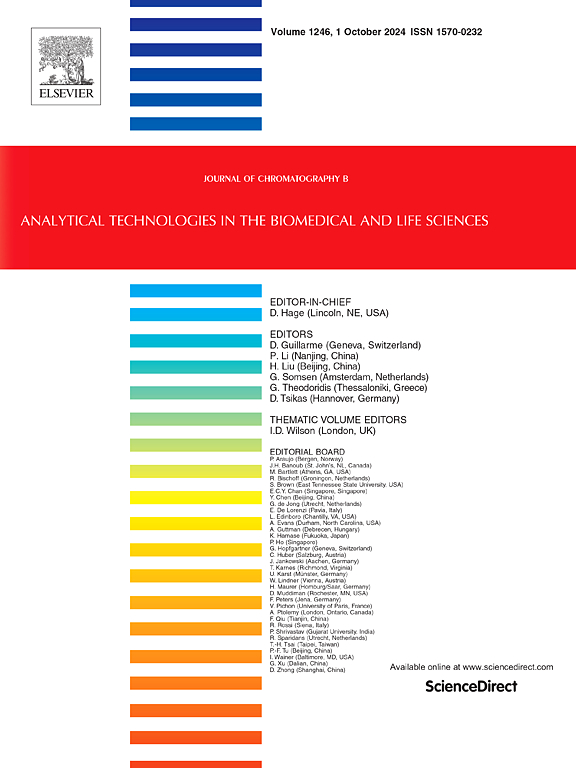Detection of flunixin meglumine in pork based on magnetic solid-phase extraction technology
IF 2.8
3区 医学
Q2 BIOCHEMICAL RESEARCH METHODS
引用次数: 0
Abstract
This study established two methods for detecting flunixin meglumine (FM) in pork. The MSPE-LC-MS/MS method utilizes the accuracy and quantifiability of liquid chromatography-tandem mass spectrometry. FM in pork can be accurately analyzed after optimizing the pretreatment, liquid phase conditions, and mass spectrometry parameters. It shows a good linear relationship (correlation coefficient > 0.999), with a detection limit of 0.2 μg/kg, limit of quantification of 0.6 μg/kg, spiked recovery rates of 90.6 % - 97.4 %, matrix effects of 96.7 % - 107.2 %, intra-day precision of 1.4 % - 5.6 %, and inter-day precision of 4.3 % - 11.5 %. The RP-MSPE-CGIA method combines the separation performance of reversed magnetic solid-phase extraction and the rapidness of colloidal gold immunochromatography. By optimizing conditions, it successfully extends the dairy product detection method to pork. It is easy to operate, has a detection limit of 5 μg/kg, and detection time less than half of MSPE - LC-MS/MS. Experiments show that the two methods complement each other in advantages and can meet the detection requirements of FM in pork in different scenarios.
基于磁固相萃取技术的猪肉中氟尼辛聚氰胺的检测
建立了两种检测猪肉中氟尼新三聚氰胺(FM)的方法。MSPE-LC-MS/MS方法具有液相色谱-串联质谱法的准确性和可定量性。通过优化预处理、液相条件和质谱参数,可以准确分析猪肉中的调色剂。两者呈良好的线性关系(相关系数>;0.999),检测限为0.2 μg/kg,定量限为0.6 μg/kg,加标回收率为90.6% ~ 97.4%,基质效应为96.7% ~ 107.2%,日内精密度为1.4% ~ 5.6%,日内精密度为4.3% ~ 11.5%。RP-MSPE-CGIA方法结合了反磁固相萃取的分离性能和胶体金免疫层析的快速。通过优化条件,成功地将乳制品检测方法扩展到猪肉。操作简便,检出限为5 μg/kg,检测时间不到MSPE - LC-MS/MS的一半。实验表明,两种方法优势互补,能够满足不同场景下猪肉中FM的检测需求。
本文章由计算机程序翻译,如有差异,请以英文原文为准。
求助全文
约1分钟内获得全文
求助全文
来源期刊

Journal of Chromatography B
医学-分析化学
CiteScore
5.60
自引率
3.30%
发文量
306
审稿时长
44 days
期刊介绍:
The Journal of Chromatography B publishes papers on developments in separation science relevant to biology and biomedical research including both fundamental advances and applications. Analytical techniques which may be considered include the various facets of chromatography, electrophoresis and related methods, affinity and immunoaffinity-based methodologies, hyphenated and other multi-dimensional techniques, and microanalytical approaches. The journal also considers articles reporting developments in sample preparation, detection techniques including mass spectrometry, and data handling and analysis.
Developments related to preparative separations for the isolation and purification of components of biological systems may be published, including chromatographic and electrophoretic methods, affinity separations, field flow fractionation and other preparative approaches.
Applications to the analysis of biological systems and samples will be considered when the analytical science contains a significant element of novelty, e.g. a new approach to the separation of a compound, novel combination of analytical techniques, or significantly improved analytical performance.
 求助内容:
求助内容: 应助结果提醒方式:
应助结果提醒方式:


